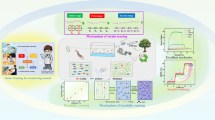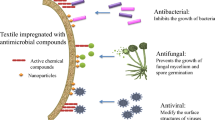Abstract
In this research, a water-soluble ultraviolet (UV) absorber (PEI-H) was synthesized by grafting polyethyleneimine (PEI) with 2,4-dihydroxybenzophenone (UV-0). UV-resistant and superhydrophobic coating was fabricated upon cotton fabric by sequentially depositing PEI-H, silica sol (SiO2) and hexadecyltrimethoxysilane via layer-by-layer assembly and dip-coating. The surface morphology, chemical composition, water-repellence, UV resistance property, durability against washing and abrasion test, air permeability as well as safety of the obtained fabric were investigated. It found that the obtained cotton fabric exhibited superior UV-resistant property with UPF value more than 800 which was attributed to the synergistic effect between organic UV absorber (UV-0) and inorganic UV shielding agent (SiO2). Meanwhile, it also possessed superhydrophobicity, self-cleaning and anti-fouling properties with water contact angle of 154°. In addition, the multifunctional fabric after 20 washing times or 300 abrasion times remained excellent hydrophobicity and the corresponding UPF values were still 400+, showing an outstanding durability. Importantly, the obtained fabric was absolutely safe for human body.
Graphic abstract












Similar content being viewed by others
References
Apaydin K, Laachachi A, Ball V, Jimenez M, Bourbigot S, Ruch D (2015) Layer-by-layer deposition of a TiO2-filled intumescent coating and its effect on the flame retardancy of polyamide and polyester fabrics. Colloid Surface A 469:1–10
Cassie ABD, Baxter S (1944) Wettability of porous surfaces. Trans Faraday Soc 40:546–551
Chen D et al (2018) UV-blocking, superhydrophobic and robust cotton fabrics fabricated using polyvinylsilsesquioxane and nano-TiO2. Cellulose 25:3635–3647
Davis S, Capjack L, Kerr N, Fedosejcvs R (1997) Clothing as protection from ultraviolet radiation: which fabric is most effective? Int J Dermatol 36:374–379
Hu X, Tian M (2015) Multifunctional cotton fabrics with graphene/polyurethane coatings with far-infrared emission, electrical conductivity, and ultraviolet-blocking properties. Carbon 95:625–633
Huang JY, Li SH, Ge MZ (2015) Robust superhydrophobic TiO2@fabrics for UV shielding, self-cleaning and oil–water separation. J Mater Chem A 3:2825–2832
Huang J et al (2019) Fabrication of multifunctional silk fabrics via one step in situ synthesis of ZnO. Mater Lett 237:149–151
Jin X, Sun X, Chen G (2015) pH-sensitive carbon dots for the visualization of regulation of intracellular pH inside living pathogenic fungal cells. Carbon 81:388–395
Li S, Quan W, Qin Z, Fu Y, Gu Y (2016) Unraveling the mystery of Stöber silica’s microporosity. Langmuir 32:9180–9187
Li Z et al (2019) Flexible all-solid planar fibrous cellulose nonwoven fabric-based supercapacitor via capillarity-assisted graphene/MnO2 assembly. J Alloy Compd 782:986–994
Liu Y et al (2015) One-step synthesis of robust nitrogen-doped carbon dots: acid-evoked fluorescence enhancement and their application in Fe3+ detection. J Mater Chem A 3:17747–17754
Lu L, Hu C, Zhu Y, Zhang H, Li R, Xing Y (2018) Multi-functional finishing of cotton fabrics by water-based layer-by-layer assembly of metal–organic framework. Cellulose 25:4223–4238
Lu Y et al (2019) Highly sensitive wearable 3D piezoresistive pressure sensors based on graphene coated isotropic non-woven substrate. Compos A Appl Sci Manuf 117:202–210
Mai Z et al (2018) Multifunctionalization of cotton fabrics with polyvinylsilsesquioxane/ZnO composite coatings. Carbohyd Polym 199:516–525
Mamnicka J, Czajkowski W (2012) New fiber-reactive UV-absorbers increasing protective properties of cellulose fibres. Cellulose 19:1781–1790
Manasek Z, Zvarai I, Luston J (1976) Synthesis of 2-hydroxy-4-(2,3-epoxypropoxy)benzophenones. J Appl Chem (USSR) 49:1129–1134
Ren G et al (2018) A simple way to an ultra-robust superhydrophobic fabric with mechanical stability, UV durability, and UV shielding property. J Colloid Interface Sci 522:57–62
Shen Y, Zhen L, Huang D, Jiang X (2014) Improving anti-UV performances of cotton fabrics via graft modification using a reactive UV-absorber. Cellulose 21:3745–3754
Tian M, Hu X (2016) Ultraviolet protection cotton fabric achieved via layer-by-layer self-assembly of graphene oxide and chitosan. Appl Surf Sci 377:141–148
Tian M, Hu X, Qu L, Zhu S, Sun Y, Han G (2016) Versatile and ductile cotton fabric achieved via layer-by-layer self-assembly by consecutive adsorption of graphene doped PEDOT: PSS and chitosan. Carbon 96:1166–1174
Wang F, Guo Z (2019) Facile fabrication of ultraviolet light cured fluorinated polymer layer for smart superhydrophobic surface with excellent durability and flame retardancy. J Colloid Interface Sci 547:153–161
Wang Q, Hauser PJ (2010) Developing a novel UV protection process for cotton based on layer-by-layer self-assembly. Carbohyd Polym 81:491–496
Wang L et al (2011) Superhydrophobic and ultraviolet-blocking cotton textiles. ACS Appl Mater Interface 3:1277–1281
Xue C, Yin W, Jia S, Ma J (2011) UV-durable superhydrophobic textiles with UV-shielding properties by coating fibers with ZnO/SiO2 core/shell particles. Adv Mater Res 22:415603
Zhang S, Xing M, Li B (2018) Biomimetic layer-by-layer self-assembly of nanofilms, nanocoatings, and 3D scaffolds for tissue engineering. Int J Mol Sci 19:1641
Zhao H et al (2019) Enhanced electrical conductivity of silver nanoparticles decorated fabrics with sandwich micro-structure coating layer based on silver colloid effect. Mater Lett 240:5–8
Zhong D, Cao Z, Wu B, Zhang Q, Wang G (2018) Polymer dots of DASA-functionalized polyethyleneimine: synthesis, visible light/pH responsiveness, and their applications as chemosensors. Sens Actuators B Chem 254:385–392
Author information
Authors and Affiliations
Corresponding author
Ethics declarations
Conflict of interest
The authors declare that they have no conflict of interest.
Additional information
Publisher's Note
Springer Nature remains neutral with regard to jurisdictional claims in published maps and institutional affiliations.
Electronic supplementary material
Below is the link to the electronic supplementary material.
Rights and permissions
About this article
Cite this article
Xiong, M., Ren, Z. & Liu, W. Fabrication of UV-resistant and superhydrophobic surface on cotton fabric by functionalized polyethyleneimine/SiO2 via layer-by-layer assembly and dip-coating. Cellulose 26, 8951–8962 (2019). https://doi.org/10.1007/s10570-019-02705-5
Received:
Accepted:
Published:
Issue Date:
DOI: https://doi.org/10.1007/s10570-019-02705-5




